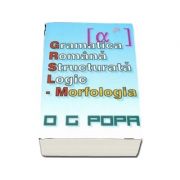L. S. E. G. 3. Logically structured english grammar, de O. G. Popa

PRP: 52,75 lei
?
Acesta este Prețul Recomandat de Producător. Prețul de vânzare al produsului este afișat mai jos.
Preț: 47,48 lei
Diferență: 5,27 lei
Disponibilitate: In stoc furnizor
Timp confirmare stoc: 1 - 2 zile lucratoare
Timp confirmare stoc: 1 - 2 zile lucratoare
Autor: O.G Popa
Editura: COMPLEMENT CONTROL
Anul publicării: 2010
DESCRIERE
Logically Structured English Grammar is upgraded with each new Edition, since our intention is to make it a serious reference of the English grammar, as complete and rigorous as possible. The sole purpose of this book is that the readers would manage to use grammar successfully in their daily activities. We are definitely not interested in promoting, or in denigrating, any models/currents/trends existing today in English grammar. Even more, the Author and the Publisher(s) claim absolutely no merits for Logically Structured English Grammar: this book presents traditional! classic English grammar which has been totally and perfectly dejined a long time ago by very many reputable gram mar researchers.
Now, since it was first issued in 2006, we have noticed that many readers have problems understanding traditional! classic grammar. In this way, we got many interesting questions from native and ESL speakers, some of them even active English teachers in reputable institutions. After five years of activity, it happened only once that we couldn't tind in our book the answer to the question submirted, but that was only because the question itself was (almost) perpendicular to grammar. Anyway, over the years we managed to build up the following global picture: people do not know grammar, mostly because there are too many books dedicated to presenting the new"modified" English grammar.
Now, there is absolutely nothing wrong with any new grammar [even ifit is ofthe"modified" type]; people are free to leamlstudy any grammar they prefer most. However, what people do not know (because they are not told about this) is, before learning any new kind of grammar, they do need to know the fundamental, basic, traditional English gram mar to perfection. Even more, there is absolutely no way around traditional English grammar, in spite of so many shortcuts proposed by too many authors.
So, this third Edition presents traditional English grammar, just as the previous versions did, except it does that with more details added. In this respect, we have marked the predicate-verbs in almost all examples using backgroundhighlighting, This was needed because the predicate-verb is thejirst and the most important reference in grammar.
In addition, we have implemented a few custom abbreviations as follows: pre-superscripts, to mark the morphologic category of the sentence elements; pre-subscripts, to mark the case category; post-superscripts, to mark the category of syntactic elements; and, finally, post-subscripts, to mark the category of clause used in complex sentence syntax.
Highlighting using underlines and bold type has been drastically simplified, in order to facilitate the process of analyzing grammatical mechanisms. Naturally, we have also added new examples, and we have increased the complexity of our charts and tables. Finally, we worked a little on the comments, so that they are more detailed now, and better focused on the topics presented.
This is about all; we hope it helps.
Pages: 638
Year: 2010
Now, since it was first issued in 2006, we have noticed that many readers have problems understanding traditional! classic grammar. In this way, we got many interesting questions from native and ESL speakers, some of them even active English teachers in reputable institutions. After five years of activity, it happened only once that we couldn't tind in our book the answer to the question submirted, but that was only because the question itself was (almost) perpendicular to grammar. Anyway, over the years we managed to build up the following global picture: people do not know grammar, mostly because there are too many books dedicated to presenting the new"modified" English grammar.
Now, there is absolutely nothing wrong with any new grammar [even ifit is ofthe"modified" type]; people are free to leamlstudy any grammar they prefer most. However, what people do not know (because they are not told about this) is, before learning any new kind of grammar, they do need to know the fundamental, basic, traditional English gram mar to perfection. Even more, there is absolutely no way around traditional English grammar, in spite of so many shortcuts proposed by too many authors.
So, this third Edition presents traditional English grammar, just as the previous versions did, except it does that with more details added. In this respect, we have marked the predicate-verbs in almost all examples using backgroundhighlighting, This was needed because the predicate-verb is thejirst and the most important reference in grammar.
In addition, we have implemented a few custom abbreviations as follows: pre-superscripts, to mark the morphologic category of the sentence elements; pre-subscripts, to mark the case category; post-superscripts, to mark the category of syntactic elements; and, finally, post-subscripts, to mark the category of clause used in complex sentence syntax.
Highlighting using underlines and bold type has been drastically simplified, in order to facilitate the process of analyzing grammatical mechanisms. Naturally, we have also added new examples, and we have increased the complexity of our charts and tables. Finally, we worked a little on the comments, so that they are more detailed now, and better focused on the topics presented.
This is about all; we hope it helps.
Pages: 638
Year: 2010
















REVIEW-URI